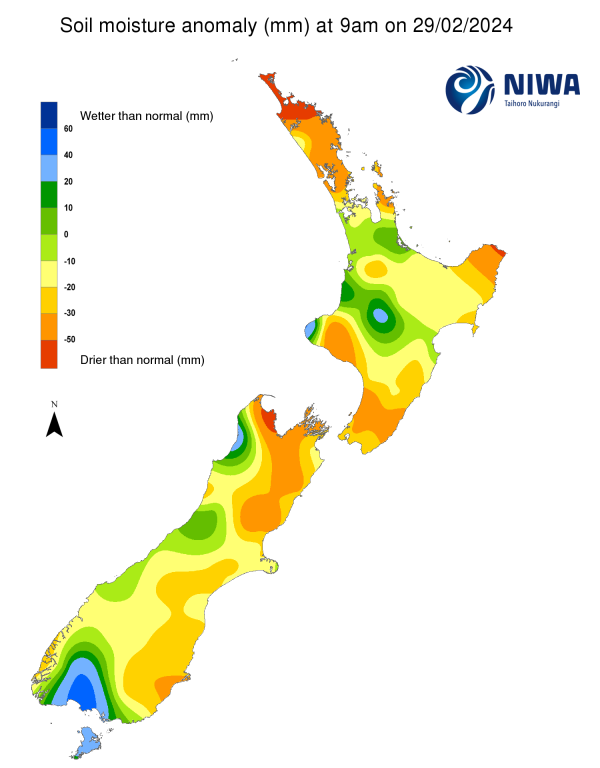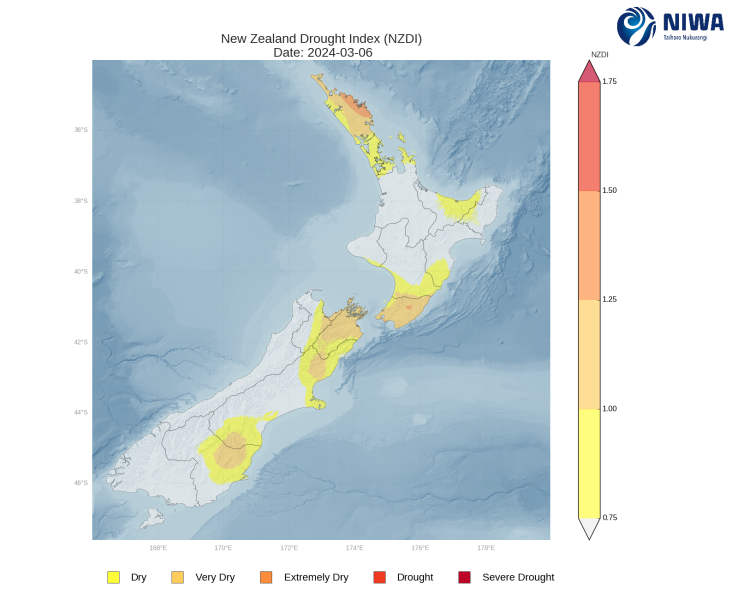Regions experiencing significant soil moisture deficits are deemed “hotspots”. Persistent hotspot regions have the potential to develop into drought.
Recent rainfall and current soil moisture conditions:
North Island:
- Much of the central and western North Island saw significant rainfall totals of 40-75 mm in the past week.
- However, amounts were more modest in regions such as Northland, Auckland and Bay of Plenty, where rainfall totals were generally 25 mm or less. Meanwhile, only meagre rainfall was observed along the east coast of the North Island.
- This resulted in small to moderate soil moisture increases across much of the North Island, most notably in central and western regions. However, some additional soil moisture decreases occurred from Hawke’s Bay to Wairarapa.
- The driest soils across the North Island, when compared to normal for this time of the year, are found in the Far North, while the wettest soils for this time of the year are found in western and southern Waikato.
- Hotspots are currently located across the Far North and eastern Northland, coastal Gisborne, and from southern Hawke’s Bay to Wairarapa.
- As of 6 March, the New Zealand Drought Index (NZDI) map below shows that abnormally dry conditions are currently found in Northland, Auckland, part of the Coromandel Peninsula, eastern Bay of Plenty, and much of the lower North Island. Very dry to extremely dry conditions are located in eastern Northland, far southern Manawatū-Whanganui, and Wellington.
South Island:
- Rainfall amounts of 40-100 mm affected the West Coast and Tasman in the past week, with a few areas receiving more than 100 mm.
- Although Southland received 25-40 mm, the upper and eastern South Island saw generally meagre rainfall amounts of 5-15 mm.
- This resulted in moderate soil moisture increases along the West Coast, but the east coast generally saw small additional decreases.
- The driest soils across the South Island, when compared to normal for this time of the year, are found across parts of Canterbury, while the wettest soils for this time of the year are found in western Southland.
- Hotspots are currently located across much of the upper and eastern South Island, including eastern Tasman, Nelson, parts of Marlborough, a majority of Canterbury, and eastern Otago.
- As of 6 March, the New Zealand Drought Index (NZDI) map below shows that abnormally dry conditions are currently found in eastern Tasman, Nelson, Marlborough, northern and far southern Canterbury, and eastern Otago. Very dry to extremely dry conditions are located in Nelson, Marlborough, northern and far southern Canterbury, and northern Otago.
Pictured above: Soil Moisture Anomaly Maps, relative to this time of year. The maps show soil moisture anomalies over the past two weeks.
As of 6 March, the New Zealand Drought Index (NZDI) map below shows that abnormally dry conditions are currently found in Northland, Auckland, part of the Coromandel Peninsula, eastern Bay of Plenty, much of the lower North Island, eastern Tasman, Nelson, Marlborough, northern and far southern Canterbury, and eastern Otago. Very dry to extremely dry conditions are located in eastern Northland, far southern Manawatū-Whanganui, Wellington, Nelson, Marlborough, northern and far southern Canterbury, and northern Otago. Please note: some hotspots in the text above may not correspond with the NZDI map. This difference exists because the NZDI uses additional dryness indices, including one which integrates the rainfall deficit over the past 60 days. Changes are therefore slower to appear in the NZDI compared to soil moisture anomaly maps that are instantaneously updated.
The week ahead:
North Island:
- High pressure is expected to bring mostly dry weather to the North Island through Monday (11 March).
- The chance for a few showers will increase on Tuesday and Wednesday (12-13 March), but any rainfall will likely be light.
- Mostly dry weather becomes favoured again during late next week.
- Weekly rainfall totals of 15 mm or less look to be widespread across the North Island in the next week. In addition, regions such as Northland and Bay of Plenty could receive less than 5 mm.
- Due to the expected rainfall in the next week, substantial soil moisture decreases could be widespread across the North Island in the next week.
- Current hotspots across the North Island will have a good chance to strengthen and expand in the next week, particularly those in Northland where weekly rainfall could be especially meagre.
South Island:
- Other than a few showers in Southland on Friday night, high pressure will bring dry weather to the South Island through Sunday (10 March).
- A front will bring moderate to heavy rain to the lower West Coast on Monday, followed by a stronger front from late Tuesday to Wednesday (12-13 March) that will bring at least some rain to a majority of the South Island, including heavy rain for parts of the West Coast.
- Scattered showers may return by next Friday (15 March).
- Weekly rainfall totals of 75-125 mm are possible in the lower West Coast, with 40-75 mm in the upper West Coast.
- While Southland may again see moderate weekly totals of 25-40 mm, rainfall amounts of 10-25 mm are likely across much of the upper and eastern South Island.
- Due to the expected rainfall in the next week, additional soil moisture decreases are possible in the upper and eastern South Island, but the lower West Coast and Southland may see small soil moisture increases.
- The current hotspots in the upper and eastern South Island could strengthen and expand at least slightly in the next week, but the changes may not be substantial.
Long-term outlook (through early April):
- The drier (25th percentile) and middle (50th percentile) rainfall scenarios both show drier or much drier than normal conditions across much of the country, especially in the North Island and upper South Island.
- In the wetter (75th percentile) scenario, below normal rainfall is still forecast in isolated areas, but near normal rainfall is most favoured across the country.
- Very dry soil conditions could affect the lower North Island and eastern South Island in all three rainfall scenarios, along with parts of the upper and eastern North Island in the drier scenario. The middle and drier scenarios also show the possibility for a small area of meteorological drought to form in the lower South Island.


Pictured above: 35-day forecast rainfall anomaly scenarios (Top), and 35-day forecast dryness and drought scenarios (Bottom). These maps are updated daily at https://niwa.co.nz/climate/seasonal-climate-outlook
Background:
Hotspot Watch: a weekly advisory service for New Zealand media. It provides soil moisture and precipitation measurements around the country to help assess whether extremely dry conditions are imminent.
Soil moisture deficit: the amount of water needed to bring the soil moisture content back to field capacity, which is the maximum amount of water the soil can hold.
Soil moisture anomaly: the difference between the historical normal soil moisture deficit (or surplus) for a given time of year and actual soil moisture deficits.
Definitions: “Extremely” and “severely” dry soils are based on a combination of the current soil moisture status and the difference from normal soil moisture (see soil moisture maps at https://www.niwa.co.nz/climate/nz-drought-monitor/droughtindicatormaps)
Hotspot: A hotspot is declared if soils are "severely drier than normal" which occurs when Soil Moisture Deficit (SMD) is less than -110 mm AND the Soil Moisture Anomaly is less than -20 mm.


![Soil moisture anomaly map (mm) at 9am on 7 March 2024. [NIWA]](/sites/default/files/styles/portrait/public/inline-images/smdanom_20240307.png?itok=dr9Hoe0p)

